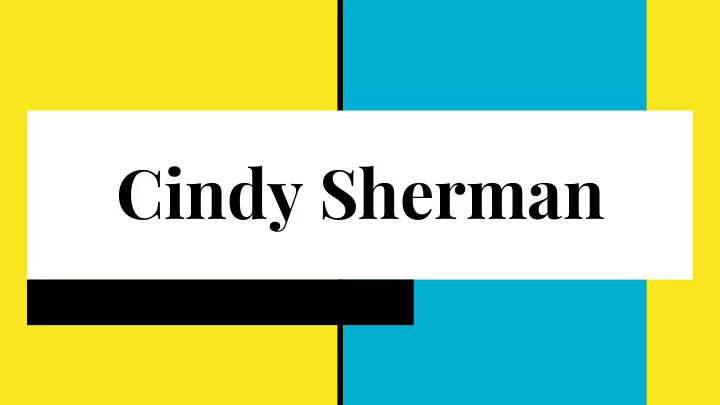

Cindy Sherman
Artist Exploration - Sherman started out as a painter in 1972. - Following drawing inspiration from pop culture imagery, film, fashion and television. - She decided to assume the role as author, director, designer and model Untitled Film Still #10,Sherman,1978 - By dressing up in various wigs and costumes to portray a wide variety of characters. - Hence, challenging the restrictives roles and presentation of women in the media and the objectification of female sexuality. - Perceiving women as the ‘other’ Untitled Film Still #58,Sherman,1980
Practice Cindy Sherman uses photography as an artistic tool to explores contemporary culture. In the untitled film still #21 she poses as a generic, female film character to make a commentary on stereotypical portrayals of women. Cindy Sherman does not aim to be a “feminist artist” but leaves her photography open to interpretation.
cindy in context and by critics and also in interviews !!!!! called a “chameleon” and a “shape shifter” sherman’s work was born out of an almost crippling shyness and fear of the outside world hailed as a feminist , postmodernist , post-structuralist ??? ?
#21 Exploration Untitled Film Still #21,1978 - The image could mimic the imagery and photography of glossy magazines or, as the name suggests, an isolated frame from a black and white film, as a V Magazine,Spring 2014 result of its deliberate and improbable perspective. - The image challenges the viewer’s conceptions of ‘reality,’ while also questioning the cultural elements that Manhattan,1978 frame our sense of an individual’s identity Interview Magazine,2015
Focal Point Meaning of Title “untitled film still 21” - Cindy Sherman is the main focal point, slightly off center in the photograph - Film still number 21 out of 70 - The background is slightly blurred, making a clear distinction between the foreground and background. Possible reasons: - Her expression of disgust, viewer inconclusive to what - generalization/stereotyping triggered response - No real identity being portrayed which relates to her aim of wanting to emphasize how the roles of women in movies are all the same - No diversity in characterization - For Sherman, ambiguity was important so just like she didn’t want people to immediately recognize the scene, hence by not having a title it leaves the interpretation of which film it may be from open “When I became involved with close-ups I needed more information in the expression. I couldn’t depend on background or atmosphere. I wanted the story to come from the face.”
Feelings and Reactions Evoked Control: sherman is entirely responsible for the scenario, every element is a deliberate and - considered choice. The highly structured nature arguably relates her work to sculpture. Reflection: The images recreate the near past (reinforced by the angle of the shot), evoking - nostalgia but also self examination and critique. Awareness: Sherman’s character gazes beyond the frame, making them appear reactive and - informing the viewer that it is a narrative with something occuring. Entire plot in one image. Anxiety: in contrast to the towering buildings, the model appears small and helpless. It is - common for victims to be ‘isolated before being subjected to violence’ in films. The sense of threat is heightened by parted lips. Mirzoeff, Nicholas. How To See The World , London: Penguin Books, 2015
Historical Influence Netherlandish Genre Painting - The genre artists used imagery from popular literature and theatre like Sherman borrows from television, novels and B-movies. Respective viewers identify with the subjects. - Jan Steen and Sherman produce works of themselves, but not self portraits. Both artists use costuming to make the distinction between themselves and character. - Sherman and genre artists use visual description Left: Untitled Film Still with still life elements arranged purposefully. A #2,Sherman,1977 high level of organisation and control is present in both works. Every detail conveys meaning. Right: Woman before mirror,Frans van Mieris, 1670 - Both “condense an entire drama” into a single image Knight, Cheryl Krause. 2004. Just another day: Dutch genre themes in cindy sherman's untitled film stills. Visual Resources 20 (4): 275.
Artist Influence-Richard Price - Part of the ‘Picture Generation’ alongside Sherman - Invented the ‘re-photography’ method, using imagery from adverts - Similarly explores visual stereotypes and appropriates images - Well known for pieces like ‘Untitled (Cowboy)’. Kroksnes, Andrea. 2002. Reframing the 80s: Visual culture and the picture generation.ProQuest Dissertations Publishing.
Political Influences - Attracted feminist readings as the work features and is produced by a woman. - Explores stereotypes and norms of the role of women. - ‘Even though I’ve never actively thought of my work as feminist or as a political statement, certainly everything in it was drawn from my observations as a woman in this culture’ - Sherman. - Undeniably female-oriented perspective, Liu, Jui-Ch'i. 2010. Female spectatorship and the masquerade: Cindy sherman's untitled film stills. History of Photography 34 (1): 79-89.)
b ibliography ??? http://www.dazeddigital.com/photography/article/32147/1/your-ultimate- guide-to-cindy-sherman https://walkerart.org/magazine/cindy-sherman-walker-art-center https://hyperallergic.com/51316/how-to-talk-about-art-cindy-sherman/ Kroksnes, Andrea. 2002. Reframing the 80s: Visual culture and the picture generation.ProQuest Dissertations Publishing.
Recommend
More recommend